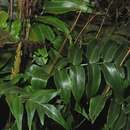Comprehensive Description
provided by North American Flora
Anemia phyllitidis (l,.) Sw. Syn. Fil. 155. 1806
Osmunda Phyllitidis X,. Sp. PI. 1064. 1753.
Anemia longifoha Raddi, PI. Bras. 1 : 69. 1825.
Anemia cordtfolia Presl, Rel. Haenk. 1 : 73. 1825.
Anemia Haenkii Presl, Rel. Haenk. 1 : 74. 1825.
Anemidictyon Phyllitidis J. Smith, in Hook. Gen. Fil. pi. 103. 1842.
Aneim-idictyum Haenkii Presl, Abh. Bohm. Ges. Wiss. V. 4 : 354. 1845.
Aneim-idictyum Haenkii cordifolium Presl, Abh. Bohm. Ges. Wiss. V. 4 : 354. 1845,
Rhizome ascending ; fronds several, fasciculate, the stipe of the fertile fronds sometimes surpassing the sterile fronds, rarely much so. Fertile fronds (including the elongate fertile pinnae) 25-70 cm. long; stipe 15-48 cm. long, usually much longer than the sterile lamina, rusty fibrillosevillous, sometimes thickly so, commonly glabrescent with age, stramineous, sulcate ; sterile lamina broadly ovate-oblong to orbicular, 7-28 cm. long, 8-25 cm. broad, simply pinnate, the rachis similar to the stipe ; pinnae 2-7 pairs, approximate or rarely apart, somewhat ascending (or the lower ones spreading), sessile or mostly shortpetiolate, subequal, or in odd-pinnate fronds the upper ones gradually smaller", lower pinnae 4-14 cm. long, 1.5-3.5 cm. broad, ovate to ovate-lanceolate or lanceolate, acute or acuminate, often attenuate, mostly falcate or subfalcate, at the base subequally rounded, less commonly subcordate or truncate, above the base inequilateral, the lower side the broadest, the costa stout, yellowish, excurrent to the apex, rusty-pilose ; succeeding pinnae similar, the upper ones usually cuneate or even excavate at the upper side of the base, rounded below, the uppermost sometimes semi-adnate below ; terminal pinna (if present) usually a little larger than the next below, truncate or inequilateral at the base, rarely joined to 1 or 2 below ; veins slightly elevated above, usually subimmersed below, copiously anastomosing, the areoles ample, elongate, oblique ; leaf-tissue herbaceosub coriaceous, somewhat lustrous above, paler and minutely glandular below, rigidly and sparingly pilose among and upon the veins both above and below, usually glabrescent ; margins crenulate to irregularly dentate, delicately cartilaginous, whitish ; fertile pinnae 8-34 cm. long, usually exceeding the sterile lamina (often much so), the panicle commonly as long as the stalk or longer, the branches usually close, with very numerous copiously fertile segments ; spores striate, echinulate. Sterile fronds smaller than the fertile, often only one half as long, rarely up to 65 cm. long ; lamina similar to that of the fertile frond.
Type locality : Santo Domingo.
Distribution : Greater Antilles (not common) ; Mexico and Central America generally ; also in South America.
- bibliographic citation
- Lucien Marcus Underwood, Ralph Curtiss BenedictWilliam Ralph Maxon. 1909. OPHIOGLOSSALES-FILICALES; OPHIOGLOSSACEAE, MARATTIACEAE, OSMUNDACEAE, CERATOPTERIDACEAE, SCHIZAEACEAE, GLEICHENIACEAE, CYATHEACEAE (pars). North American flora. vol 16(1). New York Botanical Garden, New York, NY

